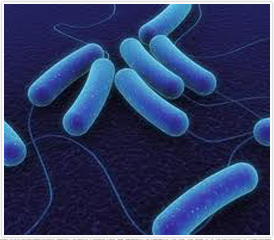
Beneficial Bacterias and Fungi
Bacillus Amyloliquefaciens
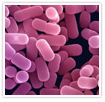 Bacillus Amyloliquefaciens: this bacterium is known for its ability to break down proteins. It has some mild antibacterial properties as well, but they are less pronounced. Bacillus Amyloliquefaciens produces and secretes amylase, an enzyme that breaks down starch into sugars the plant can use. It also secretes an antibiotic protein called barnase, however it also tells the host plant to begin manufacturing a barnase inhibitor called barstar.It also provides protection against various soilborn diseases and strengthens plants' vitality and yield.
Bacillus Amyloliquefaciens: this bacterium is known for its ability to break down proteins. It has some mild antibacterial properties as well, but they are less pronounced. Bacillus Amyloliquefaciens produces and secretes amylase, an enzyme that breaks down starch into sugars the plant can use. It also secretes an antibiotic protein called barnase, however it also tells the host plant to begin manufacturing a barnase inhibitor called barstar.It also provides protection against various soilborn diseases and strengthens plants' vitality and yield.
Bacillus Licheniformis
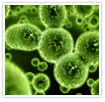 Bacillus Licheniformis: produces protease (binds amino acids into proteins) and amylase (breaks down starch into sugars). By breaking down the plants food ahead of time, your plants gets to use its energy on more important things like making better buds. Also colonies of Bacillus Lichenformis near the root zone stimulate root production, as well as secondary stem growth.
Bacillus Licheniformis: produces protease (binds amino acids into proteins) and amylase (breaks down starch into sugars). By breaking down the plants food ahead of time, your plants gets to use its energy on more important things like making better buds. Also colonies of Bacillus Lichenformis near the root zone stimulate root production, as well as secondary stem growth.
Bacillus Pumilus
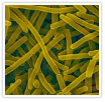 Bacillus Pumilus: acts as a fungicide by preventing the development of fungal spores on plants. It forms a physical barrier between the plant leaf and the fungal spores, and then colonizes the spores. B. pumilus also stimulates the plants own resistance system by inducing systemic acquired resistance (SAR). It also fights fungal pests such as molds, mildews, blights, rusts.
Bacillus Pumilus: acts as a fungicide by preventing the development of fungal spores on plants. It forms a physical barrier between the plant leaf and the fungal spores, and then colonizes the spores. B. pumilus also stimulates the plants own resistance system by inducing systemic acquired resistance (SAR). It also fights fungal pests such as molds, mildews, blights, rusts.
Bacillus Megaterium
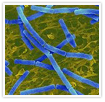 Bacillus Megaterium: Produces Penicillin amidase for constructing penicillins, enzymes for modifying corticosteroids, and several amino acid dehydrogenases. This helps plants fight any invasion of disease.
Bacillus Megaterium: Produces Penicillin amidase for constructing penicillins, enzymes for modifying corticosteroids, and several amino acid dehydrogenases. This helps plants fight any invasion of disease.
Bacillus Subtilis
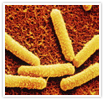 Bacillus Subtilis: is so strong that it practically cannibalizes all harmful microorganisms. It is one of the most potent and beneficial of all health-promoting and immune-stimulating bacteria. Bacillus Subtilis are able to activate nearly all systems of the plant immune defense.
Bacillus Subtilis: is so strong that it practically cannibalizes all harmful microorganisms. It is one of the most potent and beneficial of all health-promoting and immune-stimulating bacteria. Bacillus Subtilis are able to activate nearly all systems of the plant immune defense.
Bacillus Amyloliquefaciens
 Bacillus Amyloliquefaciens: this bacterium is known for its ability to break down proteins. It has some mild antibacterial properties as well, but they are less pronounced. Bacillus Amyloliquefaciens produces and secretes amylase, an enzyme that breaks down starch into sugars the plant can use. It also secretes an antibiotic protein called barnase, however it also tells the host plant to begin manufacturing a barnase inhibitor called barstar.It also provides protection against various soilborn diseases and strengthens plants' vitality and yield.
Bacillus Amyloliquefaciens: this bacterium is known for its ability to break down proteins. It has some mild antibacterial properties as well, but they are less pronounced. Bacillus Amyloliquefaciens produces and secretes amylase, an enzyme that breaks down starch into sugars the plant can use. It also secretes an antibiotic protein called barnase, however it also tells the host plant to begin manufacturing a barnase inhibitor called barstar.It also provides protection against various soilborn diseases and strengthens plants' vitality and yield. Bacillus Licheniformis
 Bacillus Licheniformis: produces protease (binds amino acids into proteins) and amylase (breaks down starch into sugars). By breaking down the plants food ahead of time, your plants gets to use its energy on more important things like making better buds. Also colonies of Bacillus Lichenformis near the root zone stimulate root production, as well as secondary stem growth.
Bacillus Licheniformis: produces protease (binds amino acids into proteins) and amylase (breaks down starch into sugars). By breaking down the plants food ahead of time, your plants gets to use its energy on more important things like making better buds. Also colonies of Bacillus Lichenformis near the root zone stimulate root production, as well as secondary stem growth.Bacillus Pumilus
 Bacillus Pumilus: acts as a fungicide by preventing the development of fungal spores on plants. It forms a physical barrier between the plant leaf and the fungal spores, and then colonizes the spores. B. pumilus also stimulates the plants own resistance system by inducing systemic acquired resistance (SAR). It also fights fungal pests such as molds, mildews, blights, rusts.
Bacillus Pumilus: acts as a fungicide by preventing the development of fungal spores on plants. It forms a physical barrier between the plant leaf and the fungal spores, and then colonizes the spores. B. pumilus also stimulates the plants own resistance system by inducing systemic acquired resistance (SAR). It also fights fungal pests such as molds, mildews, blights, rusts.Bacillus Megaterium
 Bacillus Megaterium: Produces Penicillin amidase for constructing penicillins, enzymes for modifying corticosteroids, and several amino acid dehydrogenases. This helps plants fight any invasion of disease.
Bacillus Megaterium: Produces Penicillin amidase for constructing penicillins, enzymes for modifying corticosteroids, and several amino acid dehydrogenases. This helps plants fight any invasion of disease. Bacillus Subtilis
 Bacillus Subtilis: is so strong that it practically cannibalizes all harmful microorganisms. It is one of the most potent and beneficial of all health-promoting and immune-stimulating bacteria. Bacillus Subtilis are able to activate nearly all systems of the plant immune defense.
Bacillus Subtilis: is so strong that it practically cannibalizes all harmful microorganisms. It is one of the most potent and beneficial of all health-promoting and immune-stimulating bacteria. Bacillus Subtilis are able to activate nearly all systems of the plant immune defense. 
 is used in foliar applications, seed treatment and soil treatment for suppression of various disease causing fungal pathogens. It has been used in the treatment of Botrytis, Fusarium and Penicillium. They parasitize other harmful fungi by literally sucking the nutrients from the pathogenic fungi hyphae. They are anaerobic fungi that only thrives in soil. T. Harzianum also helps a plant's ability to uptake nutrients by creating a "enzymatic smoothie" in the soil where it sucks the life out of it's prey. Sound Dramatic? It is because it can literally save any garden from pathogenic fungi that are quick to colonize and kill your plants. T. Konigii can also reduce the volume of harmful nematodes by attaching onto the larvae of the predator nematode, not allowing continued growth. Trichoderma it the most common fungi in the soil, so it is not necessary to add in a natural environment. But, gardens are not a natural environment, so DEM feels (as well as reasearch shows) that adding 2 of the most important trichoderma fungi is important to keep your soil and gardens beneficial and healthy.
is used in foliar applications, seed treatment and soil treatment for suppression of various disease causing fungal pathogens. It has been used in the treatment of Botrytis, Fusarium and Penicillium. They parasitize other harmful fungi by literally sucking the nutrients from the pathogenic fungi hyphae. They are anaerobic fungi that only thrives in soil. T. Harzianum also helps a plant's ability to uptake nutrients by creating a "enzymatic smoothie" in the soil where it sucks the life out of it's prey. Sound Dramatic? It is because it can literally save any garden from pathogenic fungi that are quick to colonize and kill your plants. T. Konigii can also reduce the volume of harmful nematodes by attaching onto the larvae of the predator nematode, not allowing continued growth. Trichoderma it the most common fungi in the soil, so it is not necessary to add in a natural environment. But, gardens are not a natural environment, so DEM feels (as well as reasearch shows) that adding 2 of the most important trichoderma fungi is important to keep your soil and gardens beneficial and healthy.